Walls That Breathe: Transforming Spaces with Living Art through Vertical Garden Design
What if the walls around you could breathe, change, and grow—turning static structures into dynamic, living masterpieces? Vertical garden design is revolutionizing the way we think about space, art, and nature, bringing life to the most unexpected places.
The Concept of Living Walls
Imagine entering a space where greenery climbs the walls, and plants become part of the architecture. Vertical gardens, also known as living walls, turn plain surfaces into thriving ecosystems. They merge design and horticulture, offering a unique way to experience nature indoors and out.
These living walls transform urban environments, adding life to concrete jungles. They provide a canvas for creativity, where plants become the medium. Whether indoors or outdoors, vertical gardens redefine how we interact with our surroundings.
The Evolution of Vertical Gardens
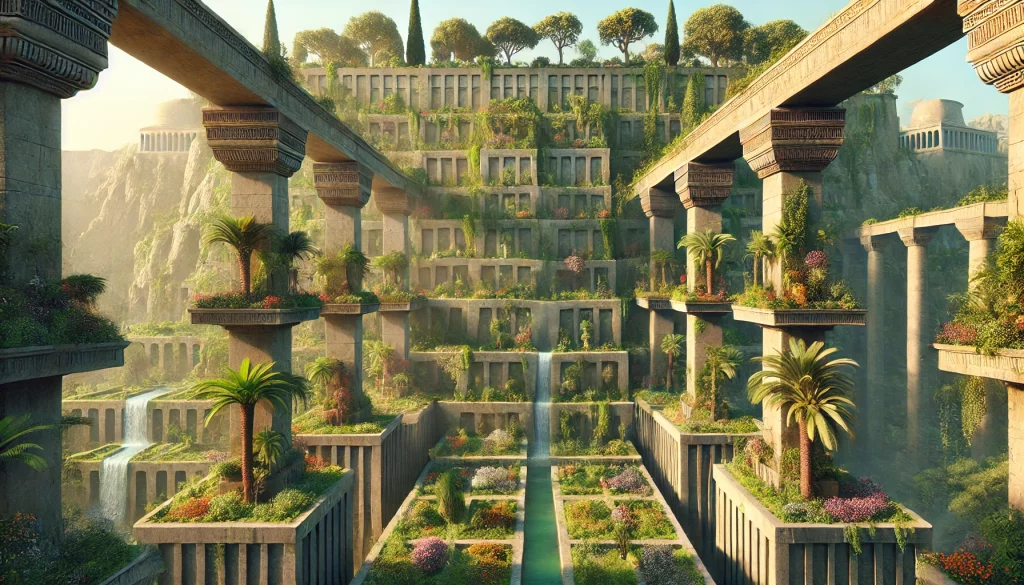
The idea of growing plants on walls isn’t new. Ancient civilizations, like the Babylonians with their Hanging Gardens, embraced vertical planting. In modern times, technological advances have brought this concept back into focus.
French botanist Patrick Blanc pioneered contemporary vertical gardening. His work demonstrated that plants could grow without soil on vertical surfaces. By using hydroponic systems and innovative structures, he inspired designers worldwide to rethink greenery in urban spaces.
Today, vertical gardens appear on skyscrapers, in offices, and even in homes. They symbolize a shift towards sustainable living and a desire to reconnect with nature. The resurgence of this age-old practice reflects our evolving relationship with the environment.
The Intersection of Art and Nature
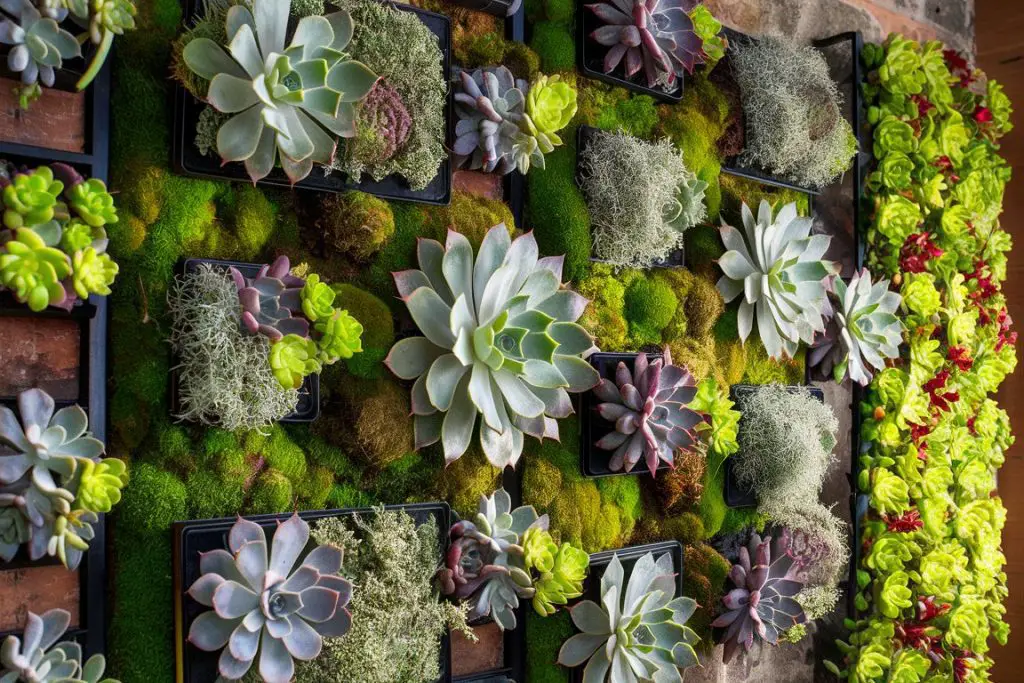
Vertical Gardens as Living Art
Plants arranged on walls can create stunning visual displays. By selecting different species and colors, designers craft living artworks that change with the seasons. The result is a dynamic piece of art that grows and evolves over time.
Iconic examples include the vertical garden at the CaixaForum Museum in Madrid. Covering an entire wall, it features over 15,000 plants from 250 species. This living tapestry draws visitors’ attention, showcasing biodiversity and artistic expression.
These gardens aren’t just decorative. They represent a fusion of creativity and ecology. The textures, patterns, and movements of plants add a new dimension to traditional art forms. They invite viewers to engage with the artwork on a deeper level.
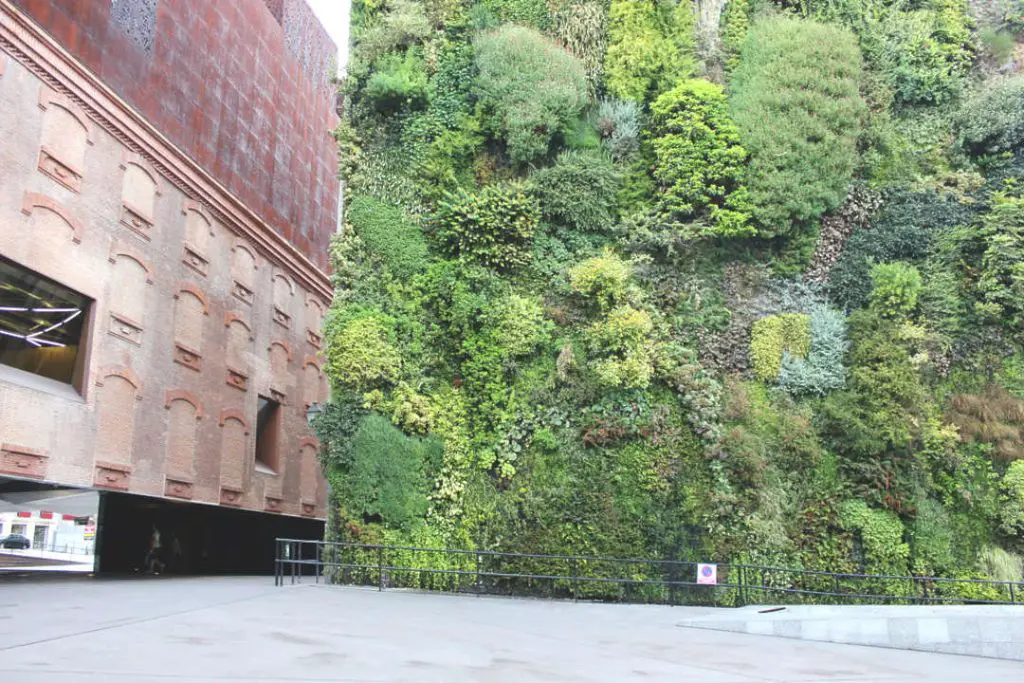
Biophilic Design Principles
Integrating nature into built environments isn’t just about aesthetics. Biophilic design connects people with natural elements to enhance well-being. It acknowledges our innate desire to interact with nature, even in urban settings.
Studies show that proximity to plants can reduce stress and improve mood. Vertical gardens offer a practical way to incorporate greenery where space is limited. They bring the calming effects of nature into offices, schools, and homes.
By embracing biophilic principles, designers create spaces that nurture both body and mind. Vertical gardens become more than decoration; they become essential components of healthy living environments.
Design Principles of Vertical Gardens
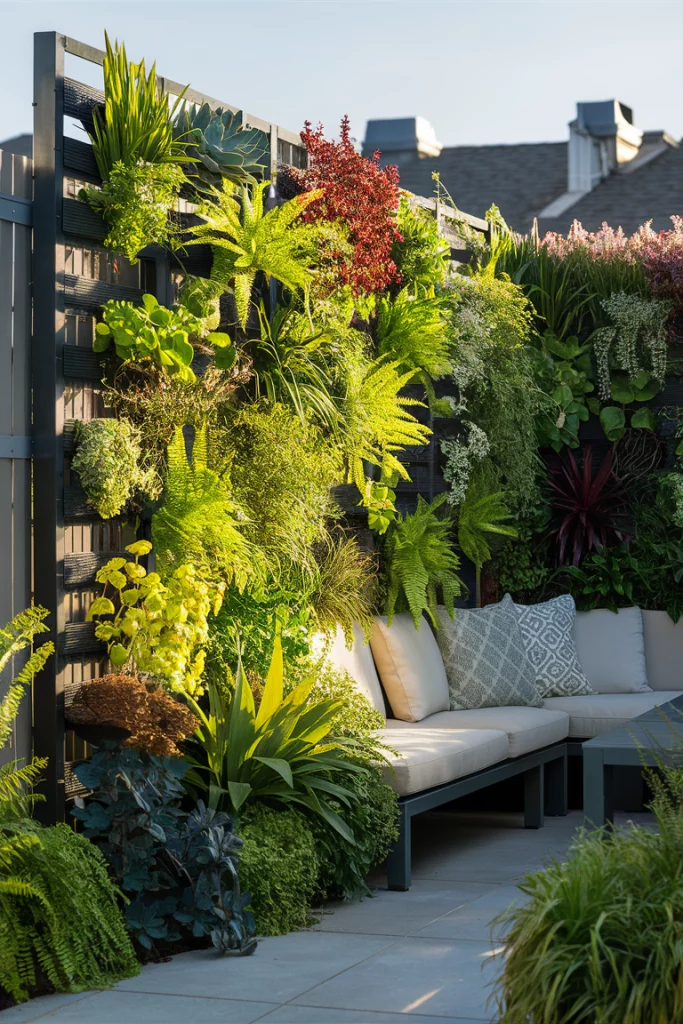
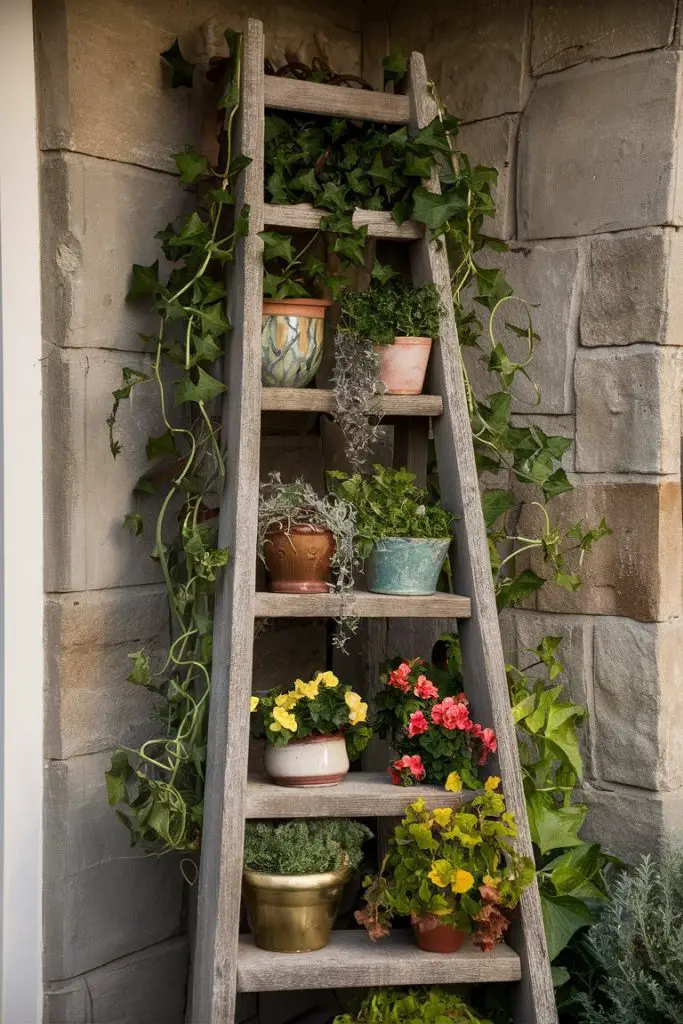
Color Theory with Foliage and Blooms
Using color effectively can evoke emotions and set moods. In vertical gardens, plant selection plays a crucial role in creating visual harmony. Bright flowers can energize a space, while soft greens promote relaxation.
Designers consider how colors interact and complement each other. For example, pairing purple lavender with silver foliage creates contrast. Planning for seasonal changes ensures the garden remains vibrant throughout the year.
Color transitions can also tell a story or represent themes. A gradient from cool blues to warm reds might symbolize a sunrise. By understanding color theory, gardeners craft experiences that resonate with viewers.
Texture and Depth
Combining plants with different shapes and sizes adds depth to a vertical garden. Vines, ferns, and succulents each bring unique textures. Layering these elements creates a tactile experience, inviting exploration.
Textures can influence how a space feels. Smooth, glossy leaves might convey elegance, while rough, fuzzy plants add a rustic touch. Mixing textures keeps the garden interesting and engaging.
Depth is achieved by arranging plants at varying distances from the wall. Some plants may protrude, while others cling closely. This variation adds dimensionality, making the garden feel more alive.
Lighting and Shadows
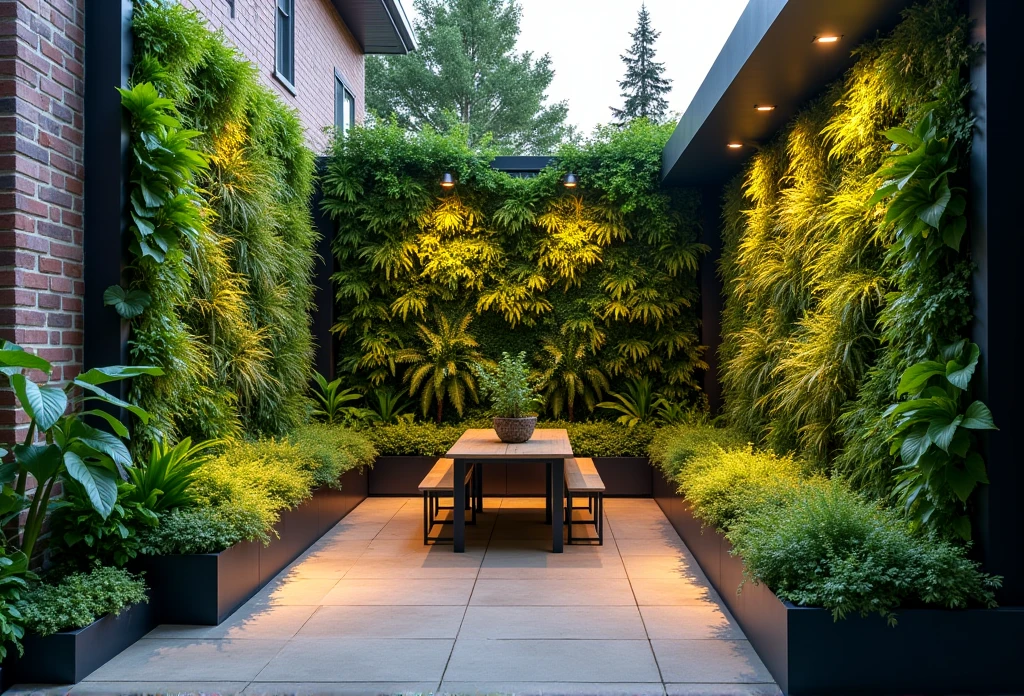
Lighting enhances the features of a living wall. Natural light creates intriguing shadows that change throughout the day. Artificial lighting allows the garden to shine at night, adding ambiance.
Strategic placement of lights highlights specific plants or areas. Uplighting can accentuate tall plants, while backlighting creates silhouettes. Understanding how light interacts with the garden enhances its visual impact.
Lighting also supports plant growth. Using grow lights ensures that plants receive adequate illumination, especially indoors. Balancing aesthetic and functional lighting needs is key to a successful design.
Innovative Techniques and Technologies
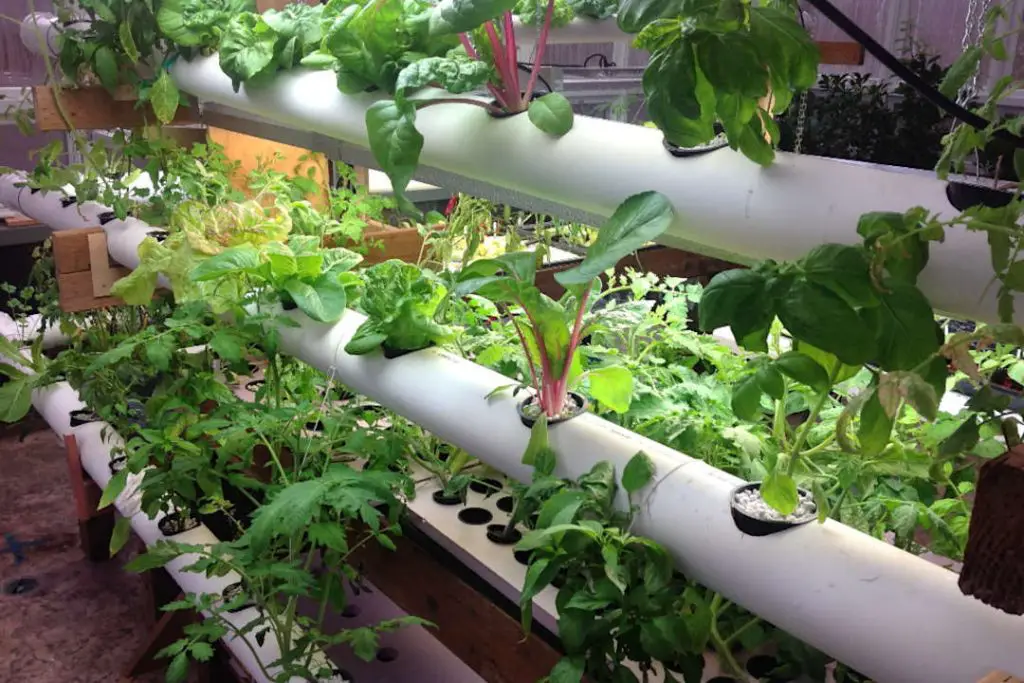
Hydroponic and Aeroponic Systems
Traditional soil isn’t always necessary for vertical gardens. Hydroponic systems allow plants to grow in nutrient-rich water. Aeroponic systems suspend roots in air, misted with nutrients.
These methods reduce weight and maintenance needs, ideal for vertical setups. They enable precise control over nutrients and water, promoting healthy growth. Plants can thrive in conditions that might be challenging with soil.
Hydroponic and aeroponic gardens also conserve water. By recycling nutrient solutions, they use less water than traditional gardening. This efficiency supports sustainability goals and reduces environmental impact.
Sustainable Materials and Structures
Using eco-friendly materials supports the sustainability of vertical gardens. Recycled plastics, natural fibers, and biodegradable substrates reduce environmental footprint. Advances in green wall technology have made these materials more accessible.
Structural components like frames and panels can be made from sustainable sources. Modular systems allow for easy installation and customization. Designers can create living walls that are both beautiful and responsible.
Incorporating rainwater harvesting and solar energy enhances sustainability. These technologies can power irrigation systems or provide additional resources. By thinking holistically, vertical gardens contribute to a greener future.
Integrating Vertical Gardens into Various Spaces
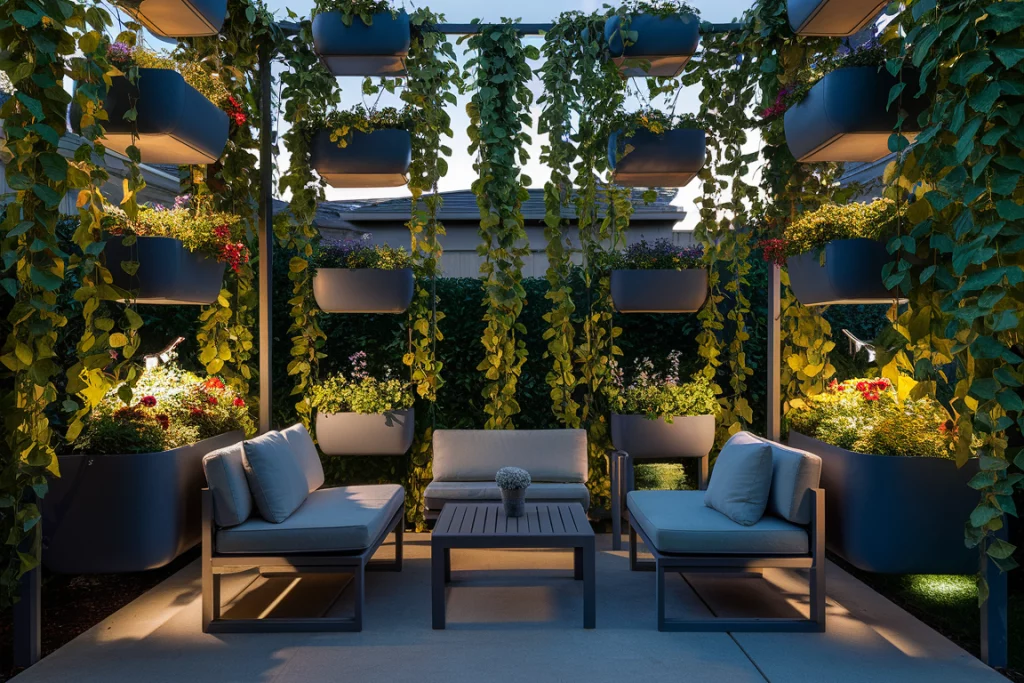
Residential Applications
In homes and apartments, vertical gardens bring nature indoors. They can transform small balconies or blank interior walls into lush green spaces. By maximizing vertical space, even those with limited room can enjoy gardening.
Indoor living walls improve air quality and add aesthetic appeal. Kitchen herb gardens provide fresh ingredients within arm’s reach. Bedroom plant walls can create a serene atmosphere conducive to relaxation.
Outdoor vertical gardens enhance patios and yards. They offer privacy screens or decorative features. Homeowners can customize their gardens to reflect personal tastes and lifestyles.
Commercial and Public Spaces
Businesses are incorporating living walls to enhance their environments. Offices with vertical gardens may see increased productivity and employee satisfaction. Green walls can reduce noise levels and create more pleasant workspaces.
In public areas, these gardens beautify urban landscapes and become landmarks. Shopping centers, hotels, and airports use living walls to create memorable experiences. They demonstrate a commitment to sustainability and community well-being.
Vertical gardens in hospitals and schools provide therapeutic benefits. Patients may heal faster with exposure to greenery. Students might find that plants enhance learning environments and reduce stress.
Urban Agriculture Initiatives
Vertical gardens aren’t just for decoration. They support urban agriculture, allowing communities to grow fresh produce in limited spaces. Rooftop farms and wall-mounted vegetable gardens contribute to local food systems.
Community centers and schools can use vertical gardening to teach about sustainability. Programs may engage residents in growing their own food, promoting healthy eating habits. This approach fosters community engagement and environmental awareness.
Urban agriculture initiatives address food deserts by providing access to fresh produce. Vertical gardens maximize space efficiency, making them suitable for dense urban areas. They represent a innovative solution to complex societal challenges.
Plant Selection for Aesthetic and Environmental Impact
Choosing the Right Plants
Selecting plants that suit the environment is essential. Factors like light, humidity, and temperature affect plant health. Understanding these conditions guides the choice of suitable species.
Native plants often require less maintenance and support local ecosystems. They may be more resistant to pests and diseases. Incorporating native flora promotes biodiversity and ecological balance.
Balancing exotic and local plants adds diversity while respecting the environment. Exotic plants can introduce unique colors and textures. Careful selection ensures they don’t become invasive or disrupt local habitats.
Creating Thematic Gardens
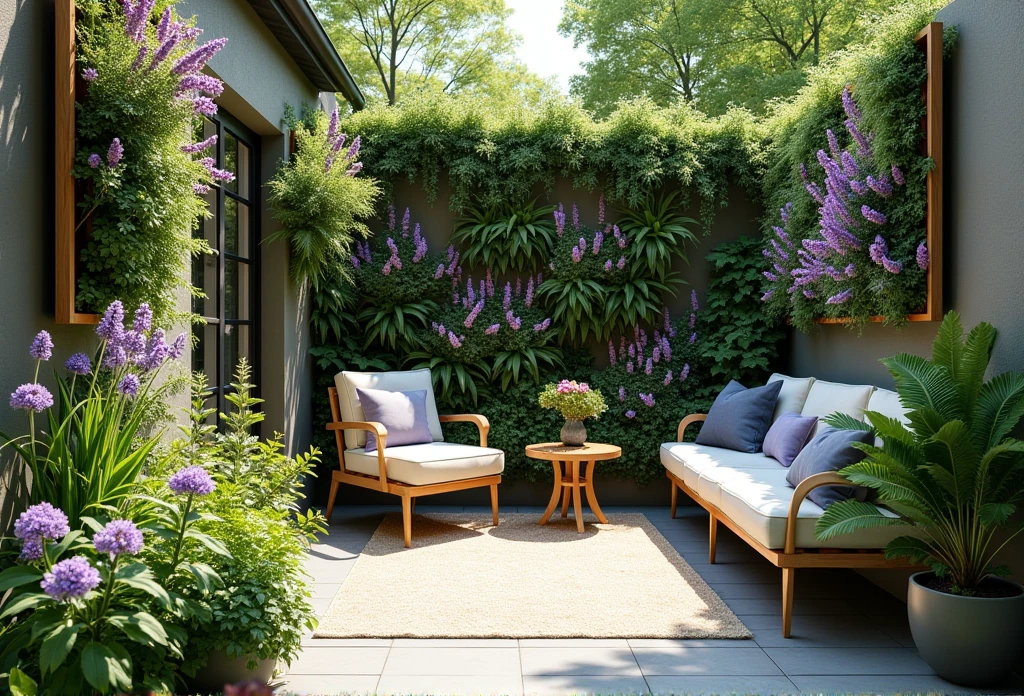
Thematic gardens focus on specific types of plants or purposes. An edible wall might feature herbs and vegetables for cooking. A sensory garden could include fragrant flowers and textured leaves.
Specialized gardens, like those that attract butterflies or purify the air, offer additional benefits. Plants like lavender and jasmine provide pleasant scents. Spider plants and peace lilies are known for air purification.
Designing with a theme adds coherence and purpose. It allows gardeners to align their interests with their spaces. Themes can be educational, aesthetic, or functional, enhancing the overall experience.
Overcoming Challenges
Structural and Load-Bearing Considerations
Installing a vertical garden requires assessing the wall’s ability to support the weight. Consulting with professionals ensures that the structure is safe and durable. Factors like wall material, weight distribution, and anchoring methods are critical.
Some systems are lightweight and modular, making them suitable for various settings. Choosing the right framework minimizes stress on the wall. Proper installation prevents damage and prolongs the garden’s life.
Understanding building codes and regulations is also important. Compliance with local guidelines ensures that the garden meets safety standards. Planning ahead avoids costly mistakes and potential hazards.
Irrigation and Drainage Solutions
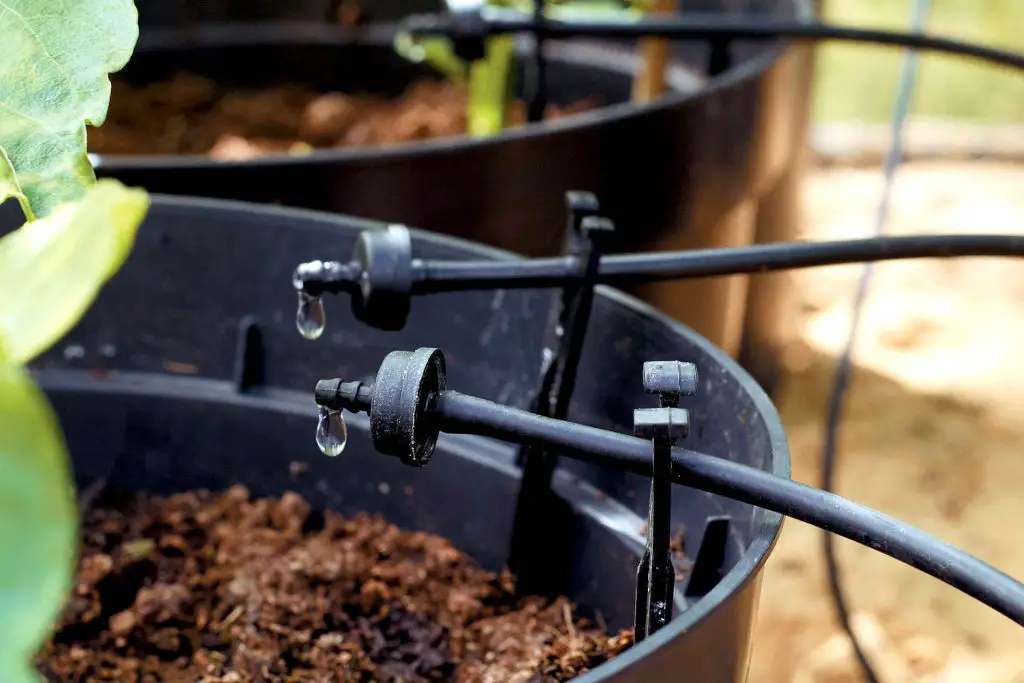
Proper watering is vital for plant health but can be challenging in vertical setups. Incorporating efficient irrigation systems prevents overwatering and runoff. Drip irrigation delivers water directly to the roots, reducing waste.
Smart irrigation technologies can monitor moisture levels and adjust watering schedules. Sensors detect when plants need water, automating the process. This approach conserves water and reduces maintenance.
Drainage is equally important. Excess water must be directed away from the wall to prevent damage. Installing drip trays or drainage layers protects the structure and maintains plant health.
Maintenance and Longevity
Regular care keeps a living wall vibrant. This includes monitoring for pests, pruning, and replacing plants as needed. Establishing a maintenance schedule ensures that issues are addressed promptly.
Understanding the specific needs of each plant aids in providing proper care. Some plants may require more frequent watering or special nutrients. Keeping records of plant health helps in making adjustments.
Planning for growth and seasonal changes ensures that the garden continues to thrive. Anticipating how plants will develop allows for strategic pruning and replanting. A well-maintained garden remains attractive and functional over time.
Environmental and Health Benefits
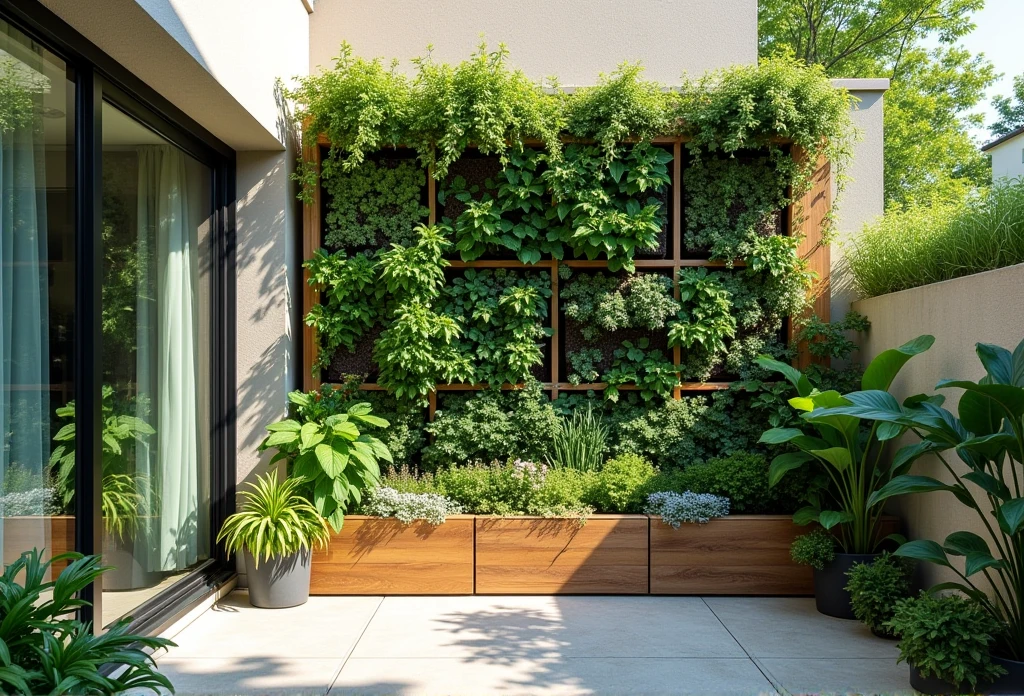
Improving Air Quality
Plants act as natural air filters, removing toxins and releasing oxygen. In indoor environments, this leads to cleaner air and improved health. Vertical gardens maximize the number of plants in a space, enhancing these benefits.
Certain plants are particularly effective at purifying air. For example, the snake plant and Boston fern absorb pollutants like formaldehyde and benzene. Including these in a living wall amplifies air-cleaning effects.
Improved air quality can reduce symptoms of allergies and respiratory issues. In workplaces, this may decrease sick days and increase productivity. The overall impact contributes to healthier living and working environments.
Energy Efficiency
Living walls contribute to a building’s insulation. They help regulate temperature by providing shade and reducing heat absorption. In hot climates, this can lower cooling costs by reducing indoor temperatures.
The plants and growing medium act as a thermal barrier. During winter, they may retain heat, reducing heating needs. This natural insulation enhances energy efficiency and reduces utility expenses.
Vertical gardens also mitigate the urban heat island effect. By adding greenery to urban areas, they help cool cities and improve comfort for residents. This environmental impact has broader implications for climate resilience.
Enhancing Mental Well-being
Being around plants has positive effects on mental health. Green spaces reduce stress, anxiety, and depression. Vertical gardens bring these benefits into homes and workplaces, supporting overall well-being.
Exposure to nature can improve concentration and creativity. In educational settings, this may enhance learning outcomes. In healthcare facilities, it may contribute to faster recovery times.
The visual appeal of a living wall can uplift moods and foster a sense of connection. Gardening activities themselves are therapeutic, providing a fulfilling hobby. Embracing vertical gardens enriches quality of life on multiple levels.
Getting Started: DIY Tips for Aspiring Vertical Gardeners
Planning Your Vertical Garden
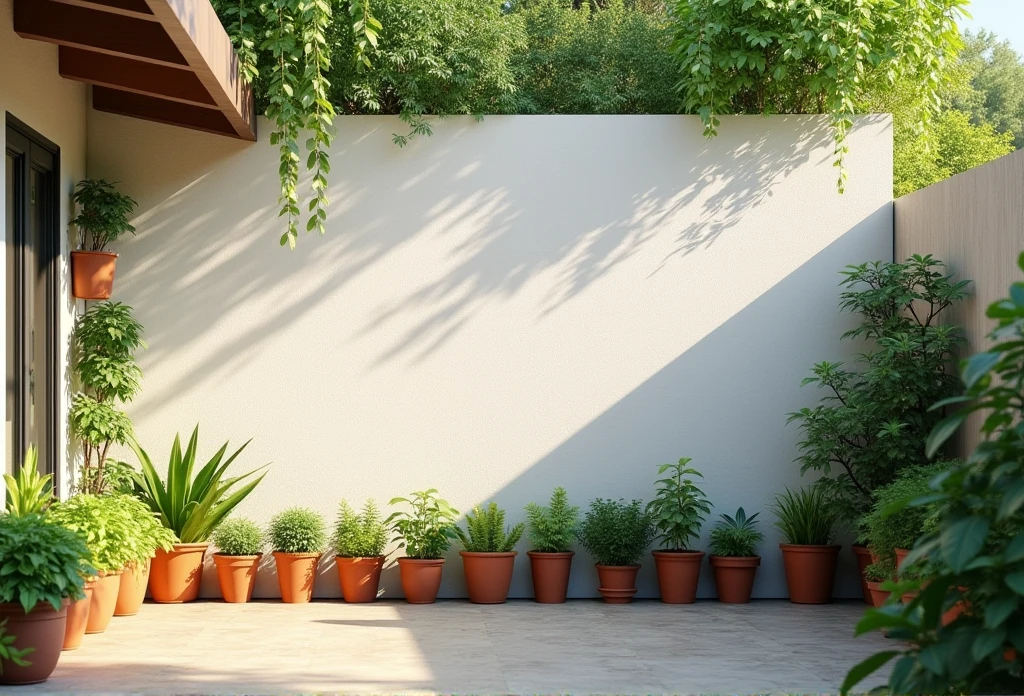
Begin by assessing your space and identifying suitable walls. Consider factors like sunlight exposure, temperature, and accessibility. Determining whether the garden will be indoors or outdoors guides material and plant choices.
Setting clear goals and a budget will shape your project. Decide whether you want a decorative feature, an herb garden, or a combination. Planning helps in selecting appropriate systems and avoiding unnecessary expenses.
Researching local regulations or building codes may be necessary. Understanding any restrictions ensures compliance and prevents future issues. Preparation is key to a successful and enjoyable gardening experience.
Essential Tools and Materials
Gather the necessary tools, such as mounting hardware, containers, and soil mixes. Frames and supports should be sturdy and appropriate for the wall type. Options include modular panels, pocket systems, or DIY solutions.
Selecting the right growing medium is crucial. Lightweight soils or hydroponic substrates reduce weight load. Fertilizers and nutrients tailored to the chosen plants promote healthy growth.
Irrigation equipment, like drip lines or reservoirs, may be needed. Tools like trowels, pruners, and moisture meters assist in planting and maintenance. Investing in quality materials ensures longevity and ease of care.
Step-by-Step Installation Guide
- Prepare the Wall: Clean the surface and inspect for structural integrity. Mark the layout and locate studs if mounting heavy systems.
- Install the Framework: Attach the support structure securely, following manufacturer instructions or design plans. Ensure it’s level and stable.
- Set Up Irrigation: Install watering systems if needed, connecting to water sources or reservoirs. Test for proper function and adjust as necessary.
- Plant Selection and Placement: Choose plants suitable for the conditions and arrange them thoughtfully. Consider growth habits and spacing.
- Planting: Place the plants into the containers or pockets, ensuring roots are well-covered. Handle plants gently to avoid damage.
- Initial Care: Water thoroughly and monitor the plants as they acclimate. Adjust lighting and temperature if indoors.
Common Mistakes to Avoid
Avoid overloading the wall with too much weight. Start with a manageable size and expand later if desired. Choose plants that match the light conditions of the space to prevent failure.
Ensure that the garden receives adequate lighting, either natural or artificial. Neglecting irrigation and drainage can lead to plant stress or wall damage. Regularly inspect for pests and address issues promptly.
Planning and patience are essential. Rushing the process may result in errors or disappointment. Learning from others and seeking advice enhances success.
The Future of Vertical Garden Design
Technological Innovations on the Horizon
Advancements in technology are shaping the future of vertical gardens. Integration with smart home systems allows for automated care. Sensors monitor soil moisture, light levels, and temperature, adjusting conditions as needed.
Responsive environments that adapt to plant needs are becoming more common. LED grow lights with customizable spectrums support specific growth stages. Mobile apps enable remote monitoring and control, making gardening more accessible.
Emerging materials like bio-engineered substrates enhance sustainability. Research into plant genetics may lead to new species suited for vertical growth. The fusion of technology and biology opens exciting possibilities.
Sustainability and Urban Planning
Cities are embracing vertical gardens as part of sustainable development. Incorporating living walls into architecture reduces the urban heat island effect. Green roofs and walls contribute to stormwater management and biodiversity.
Policies promoting green building practices encourage adoption. Incentives for energy efficiency and environmental stewardship support integration. Urban planners recognize the role of vertical gardens in creating livable cities.
Collaborations between governments, businesses, and communities drive innovation. Educational programs and public installations raise awareness. The movement towards greener cities reflects a collective commitment to the environment.
Inspiring a Greener Lifestyle
Vertical gardens inspire individuals to think creatively about their spaces. They encourage a connection with nature, even in densely populated areas. By embracing living walls, people contribute to environmental stewardship.
The trend promotes mindfulness about consumption and sustainability. Growing food or plants fosters appreciation for natural processes. Sharing experiences and knowledge builds community and inspires others.
Embracing vertical gardening aligns with broader efforts to live sustainably. It represents a tangible way to make a positive impact. The walls around us become symbols of growth, renewal, and possibility.
Final Thoughts
Embracing the Possibilities
Vertical garden design offers a way to enrich our lives by bringing nature into unexpected places. Transforming walls into living art changes how we experience our surroundings. It’s an invitation to see the potential in every surface.
The fusion of art, technology, and ecology creates opportunities for innovation. Whether in homes, businesses, or public spaces, vertical gardens make a statement. They reflect values of beauty, sustainability, and connection.
Time to Start Creating Your Own Vertical Garden
If you are emboldened by the above ethos it is time to consider starting your own vertical garden. Whether it’s a small indoor wall, small garden or a large outdoor installation, the possibilities are endless. Explore resources, connect with local gardening communities, and let your walls come alive.
By taking this step, you contribute to a greener world. You enhance your environment and inspire others. The journey begins with a single plant and grows into something extraordinary.
